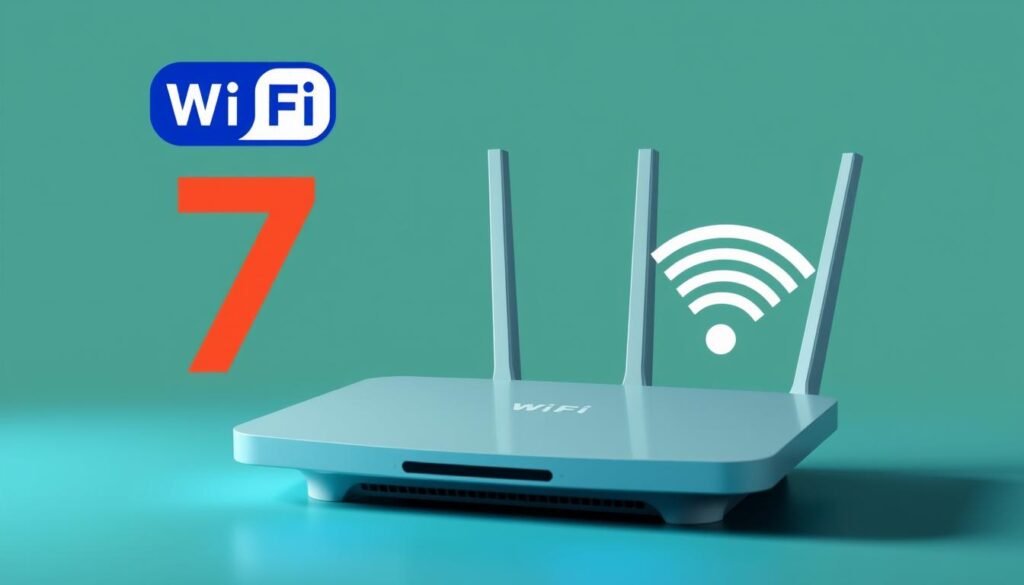Are you ready for a quantum leap in wireless connectivity? Imagine a world where your multiple devices can seamlessly connect to the network without a hitch, enjoying faster speeds and lower latency. This is not a distant future; it’s the promise of Wi-Fi 7, the latest advancement in wireless technology.
The latest standard, IEEE 802.11be, is designed to address the growing demands of today’s connected world, where data consumption is skyrocketing and the need for efficient throughput is paramount. With Wi-Fi 7, you can expect significant improvements in network bandwidth utilization, making it a game-changer for both everyday use and emerging technologies.
Key Takeaways
- Wi-Fi 7 represents a significant leap forward in wireless connectivity.
- It promises faster speeds and lower latency.
- Improved efficiency for multiple device connections.
- Designed to meet the demands of emerging technologies.
- Enhanced network bandwidth utilization for better user experience.
The Evolution of Wireless Standards
The evolution of wireless standards has been a continuous process, driven by growing demands for faster and more reliable connections. As technology advances, the need for improved wireless connectivity becomes increasingly important.
From Wi-Fi 1 to Wi-Fi 6E: A Brief History
Wi-Fi has come a long way since its introduction, with each new generation bringing significant improvements. Wi-Fi 6, for instance, offered 37% faster speeds than its predecessor, although it was not as impactful as the 10-fold rate increase that Wi-Fi 5 brought. The primary goal of Wi-Fi 6 was to enhance efficiency rather than just increasing data rates.
The Need for a New Standard
The limitations of Wi-Fi 6/6E have necessitated the development of a new standard. Key factors driving this need include:
- Increasing device density and demanding applications like AR/VR, 8K streaming, and cloud gaming.
- The proliferation of smart home devices, IoT sensors, and connected appliances, creating demand for more efficient network management.
- The growing need for lower latency in applications such as competitive gaming and industrial automation.
As a result, Wi-Fi 7 is being developed to address these challenges, focusing on greater speed, reduced latency, and improved efficiency in handling multiple simultaneous connections across numerous devices.
| Wi-Fi Generation | Key Features | Improvements |
|---|---|---|
| Wi-Fi 6 | Improved efficiency, faster speeds | 37% faster than Wi-Fi 5 |
| Wi-Fi 7 | Higher throughput, lower latency | Designed for demanding applications and increased device density |
What is Wi-Fi 7? Understanding 802.11be
The next generation of Wi-Fi, Wi-Fi 7, is designed to address the growing demands for faster, more reliable, and efficient wireless connectivity. WiFi 7 makes giant strides in throughput — 480% more than previous generations.
Official Definition and IEEE Standards
Wi-Fi 7, officially known as 802.11be, is the latest standard in the Wi-Fi series, defined by the IEEE (Institute of Electrical and Electronics Engineers). It is designed to operate in various frequency bands, including the 2.4 GHz, 5 GHz, and 6 GHz bands, ensuring optimal performance across different environments.
Key Objectives Behind Wi-Fi 7 Development
The development of Wi-Fi 7 was driven by several key objectives, including:
- Delivering deterministic latency and jitter performance for time-sensitive applications like industrial automation, gaming, and virtual reality.
- Improving spectrum efficiency to support more users and devices in congested environments without compromising network performance.
- Better utilizing available frequency bands and channels to maximize data throughput and reliability.
- Creating a more resilient network architecture that can adapt to interference and changing conditions.
- Ensuring backward compatibility to facilitate a smooth transition from older standards.
Technical Specifications of Wi-Fi 7
As the latest iteration in wireless standards, Wi-Fi 7 introduces several key technical improvements that enhance your wireless networking experience. These advancements are designed to provide faster data transfer rates, lower latency, and more reliable connections.
Frequency Bands and Spectrum Usage
Wi-Fi 7 operates across various frequency bands, including the 2.4 GHz, 5 GHz, and 6 GHz spectrums. This multi-band support allows for more flexible and efficient use of available spectrum, reducing congestion and improving overall network performance.
Maximum Data Rates and Throughput
Wi-Fi 7 achieves significantly higher maximum data rates compared to its predecessors. With the ability to reach data rates of up to 30 Gbps, Wi-Fi 7 enables smoother and more efficient data-intensive applications, enhancing your overall wireless experience.
Latency Improvements
One of the standout features of Wi-Fi 7 is its ability to achieve ultra-low latency, with improvements of up to 4 times compared to Wi-Fi 6/6E. This reduction in latency is crucial for time-sensitive applications such as online gaming, video conferencing, and industrial automation, ensuring that you experience minimal delays and buffering.
The technical mechanisms behind Wi-Fi 7’s latency reduction include more efficient packet scheduling and transmission techniques. Additionally, enhancements to Target Wake Time (TWT) contribute to better latency management while also improving power efficiency for mobile devices.
Revolutionary Features of Wi-Fi 7
The latest wireless standard, Wi-Fi 7, brings with it a host of innovative features that promise to transform your wireless experience. These advancements are designed to address the growing demands for faster, more reliable, and efficient wireless connectivity.
320 MHz Channel Bandwidth
Wi-Fi 7 supports 320 MHz channel bandwidth, doubling the maximum channel width compared to Wi-Fi 6. This significant increase allows for more data to be transmitted simultaneously, resulting in higher throughput and better performance in congested environments.
4096-QAM Modulation
The introduction of 4096-QAM modulation in Wi-Fi 7 enables more data to be encoded into each signal, thereby increasing the overall data transfer rate. This feature is particularly beneficial for applications requiring high data rates, such as video streaming and online gaming.
Multi-Link Operation (MLO)
Multi-Link Operation (MLO) is a feature that allows Wi-Fi 7 devices to transmit data across multiple frequency bands simultaneously. This capability enhances the overall efficiency and reliability of the wireless connection, reducing latency and improving overall network performance.
Preamble Puncturing
Preamble Puncturing is a groundbreaking feature that allows Wi-Fi 7 devices to selectively avoid portions of a channel affected by interference while still utilizing the rest of the channel bandwidth. This results in more efficient spectrum utilization, especially in congested environments where clean, contiguous channels are scarce. By working in conjunction with wider channels, Preamble Puncturing maintains high performance even in the presence of interference, thereby contributing to the overall efficiency and reliability of Wi-Fi 7 networks.
- Preamble Puncturing enables Wi-Fi 7 devices to avoid interference by selectively blocking affected portions of a channel.
- This feature allows for more efficient use of the available spectrum, particularly in dense urban environments.
- By maintaining high performance despite interference, Preamble Puncturing enhances the overall robustness of Wi-Fi 7 networks.
Wi-Fi 7 vs. Previous Standards: A Comprehensive Comparison
Wi-Fi 7 marks a significant leap forward in wireless technology, offering substantial improvements over its predecessors. As the latest wireless standard, Wi-Fi 7 is designed to provide a more efficient, reliable, and high-speed network experience.
Speed and Performance Differences
Wi-Fi 7 significantly enhances speed and performance compared to earlier standards. With its ability to utilize a 320 MHz channel bandwidth and 4096-QAM modulation, Wi-Fi 7 achieves higher data rates and better throughput. This results in a more seamless experience for users, especially in high-density environments.
The improvements in Wi-Fi 7 are evident when comparing its maximum data rates to those of previous standards. Wi-Fi 7’s advanced technologies enable it to support more devices and applications, making it ideal for demanding use cases like gaming and virtual reality.
Efficiency and Reliability Improvements
Wi-Fi 7 introduces several features that enhance efficiency and reliability, including Multi-Link Operation (MLO) and Preamble Puncturing. These features help minimize interference and optimize network performance, even in congested areas.
- Improved spectral efficiency allows for more data to be transmitted using the same amount of spectrum.
- Better resistance to interference ensures a more consistent network experience.
- Enhanced power efficiency optimizes energy usage despite higher performance capabilities.
Real-World Applications and Benefits
The advent of Wi-Fi 7 brings with it a host of benefits and applications that are set to transform our digital landscape. As major manufacturers and organizations gear up to accommodate Wi-Fi 7-enabled devices, widespread uptake has already begun for routers, access points, and client devices.
Smart Home and IoT Connectivity
Wi-Fi 7 is poised to revolutionize smart home and IoT connectivity by providing faster, more reliable connections for a multitude of devices. This enables seamless integration and control of various smart devices, enhancing the overall user experience.
Gaming and Entertainment
For gamers and entertainment enthusiasts, Wi-Fi 7 offers significant improvements in performance, reducing latency and increasing throughput. This results in a more immersive experience with fewer interruptions.
Business and Enterprise Solutions
In business and enterprise settings, Wi-Fi 7’s advanced capabilities support bandwidth-intensive applications like video conferencing and large file transfers. It also enhances networks by providing better prioritization of critical applications for different user groups, ensuring quality of service and supporting compliance requirements for sensitive business data.

Wi-Fi 7 Compatible Devices
With Wi-Fi 7 gaining traction, manufacturers are now focusing on creating compatible devices. This shift is crucial for consumers looking to upgrade their network infrastructure to take full advantage of Wi-Fi 7’s capabilities.

Routers and Access Points
The backbone of any Wi-Fi network, routers and access points, are being upgraded to support Wi-Fi 7. These devices are crucial for providing the faster data transfer rates and improved network efficiency that Wi-Fi 7 promises. Manufacturers are incorporating Wi-Fi 7 technology into their products, offering varying levels of support across different price points.
Smartphones, Laptops, and Other Devices
Smartphones, laptops, and tablets are among the consumer devices starting to support Wi-Fi 7. This support means faster data transfer, improved battery life through more efficient connections, and better performance in congested areas. As more devices become Wi-Fi 7 compatible, consumers will be able to fully appreciate the benefits of this new technology.
Implementation Timeline and Adoption
As Wi-Fi technology continues to evolve, the implementation timeline for Wi-Fi 7 is becoming a focal point for industry stakeholders. The adoption of this new standard will be influenced by various factors, including device replacement cycles and cost considerations.
Current Status of Wi-Fi 7 Deployment
Currently, Wi-Fi 7 is in the early stages of deployment. Chipset manufacturers play a crucial role in determining the availability of Wi-Fi 7-capable devices. As more devices enter the market, the case for widespread adoption becomes increasingly compelling, especially for households and businesses with multiple internet users.
The initial rollout is expected to target early adopters and enterprise networks that require high-bandwidth, low-latency connections.
Expected Widespread Availability
Wi-Fi 7 is expected to gain mainstream acceptance as the technology matures and becomes more affordable. The band spectrum utilized by Wi-Fi 7 will offer superior performance, making it attractive for various applications, from smart homes to industrial IoT solutions.
- Mainstream adoption is forecasted to occur within the next few years.
- Factors influencing adoption include device costs and competing technologies.
- The rollout will progress from early adopters to mainstream users.
Challenges and Limitations of Wi-Fi 7
As Wi-Fi 7 promises to revolutionize wireless connectivity, it’s crucial to examine the challenges that come with this advanced technology. While Wi-Fi 7 offers numerous benefits, including faster data rates and lower latency, its implementation is not without its hurdles.
Backward Compatibility Considerations
One of the significant challenges facing Wi-Fi 7 is ensuring backward compatibility with existing devices. As you upgrade to Wi-Fi 7, you need to consider the compatibility of your current devices and whether they can seamlessly integrate with the new standard. Although Wi-Fi 7 is designed to be backward compatible, the full benefits of the technology can only be realized with compatible devices.
To take full advantage of Wi-Fi 7, you will need to invest in new hardware that supports the latest standard. This includes not just routers and access points but also client devices such as smartphones and laptops.
Infrastructure Requirements
To fully leverage the power of Wi-Fi 7, advanced hardware is essential. This includes high-speed internet connections, advanced routers, and compatible client devices. You will also need to consider the backhaul requirements for your Wi-Fi 7 network, ensuring that you have multi-gigabit wired connections to avoid bottlenecks.
The table below outlines the key infrastructure requirements for Wi-Fi 7:
| Infrastructure Component | Requirements for Wi-Fi 7 |
|---|---|
| Internet Connection | High-speed connection (multi-gigabit) |
| Routers and Access Points | Advanced routers and access points supporting Wi-Fi 7 |
| Client Devices | Smartphones, laptops, and other devices compatible with Wi-Fi 7 |
| Backhaul Connections | Multi-gigabit wired connections |

Additionally, you must consider the power and cooling requirements for high-performance Wi-Fi 7 equipment, particularly in enterprise deployments. The placement and density of access points will also be critical in ensuring optimal network performance and minimizing interference from other devices operating in the 2.4 GHz, 5 GHz, and 6 GHz bands.
Future-Proofing Your Network for Wi-Fi 7
To leverage the full potential of Wi-Fi 7, you need to assess and potentially upgrade your current network setup.

Upgrade Strategies and Recommendations
Upgrading to Wi-Fi 7 involves investing in compatible routers and devices. Consider NETGEAR Orbi and Nighthawk WiFi 7 products, which create a seamless WiFi experience across your entire home or office network. These products offer advanced features like 10 Gig and 2.5 Gig Ethernet ports for dedicated device connections, enhancing overall performance.
Cost Considerations
When upgrading, consider the total cost of ownership, including initial investment and ongoing maintenance. Analyze the cost premium for Wi-Fi 7 equipment and project future price evolutions. A cost-benefit analysis will help determine if the performance improvements justify the investment for your specific needs, ensuring a superior internet experience.
Conclusion
Wi-Fi 7 represents a significant leap forward in wireless technology, promising to transform the way you connect and interact. With its faster speeds and lower latency, Wi-Fi 7 enables a vastly improved real-time gaming and streaming experience.
Key advancements include 320 MHz channels, 4096-QAM, and Multi-Link Operation, which together deliver superior performance and capacity. As you consider upgrading to Wi-Fi 7, strategic planning is crucial to maximize benefits while managing costs.
Stay informed about Wi-Fi 7 developments and carefully evaluate your connectivity needs to make the most of this technology.



